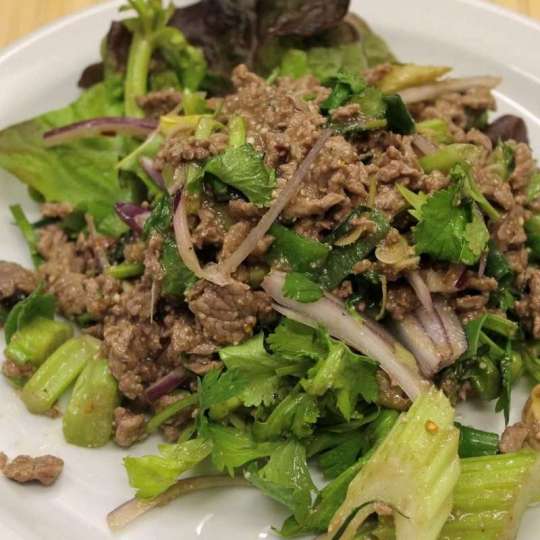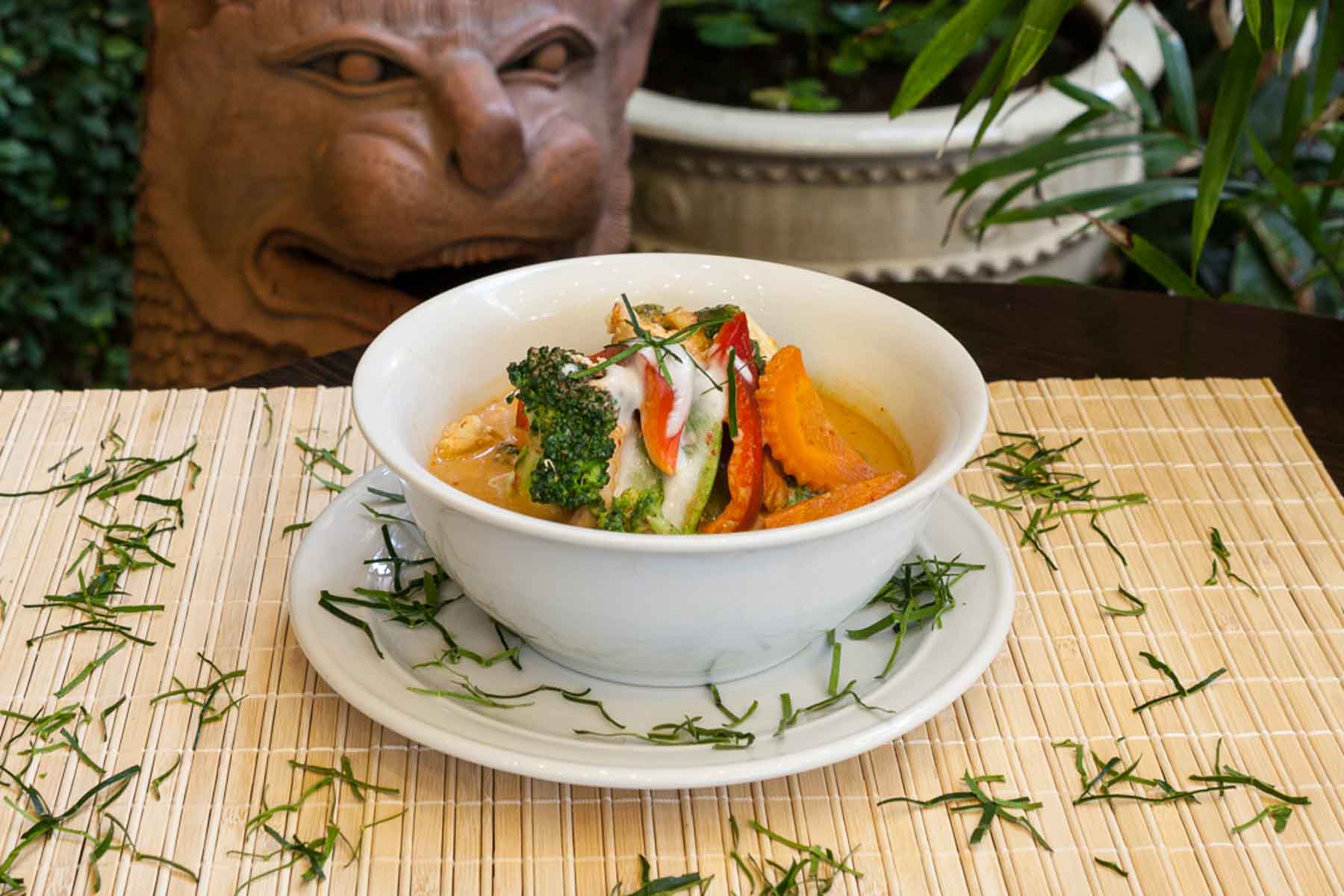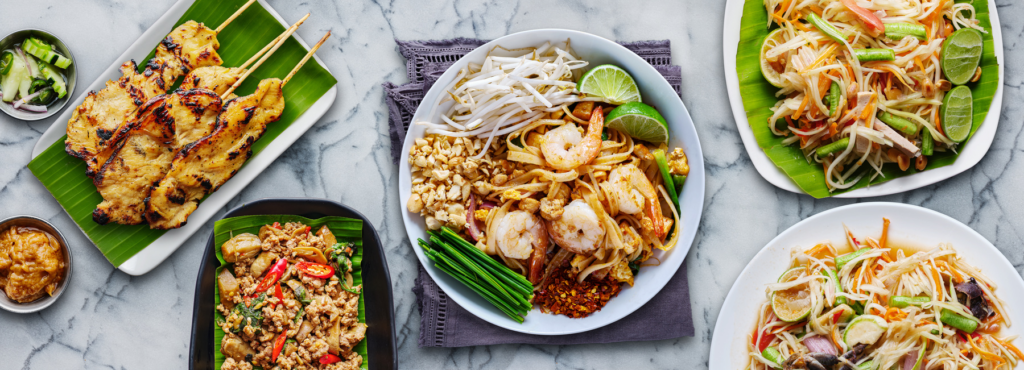
Thai cuisine has gained significant popularity in Australia, particularly in areas like Woy Woy, where diverse culinary experiences thrive. Beyond its delicious taste, Thai food offers numerous health benefits that are worth exploring and understanding in the context of Australian communities like Woy Woy.
In Woy Woy, Thai cuisine has become a beloved culinary choice, thanks to its vibrant flavours, aromatic herbs, and diverse culinary techniques. From local Thai restaurants to home kitchens, Woy Woy residents enjoy the rich tapestry of Thai dishes, each offering a unique blend of sweet, sour, salty, bitter, and spicy elements. Whether it’s the iconic Pad Thai, the fragrant Green Curry, or the comforting Tom Yum Soup, Thai cuisine holds a special place in the hearts and palates of Woy Woy locals.
While Thai food is celebrated for its delicious taste in Woy Woy, it also offers significant health benefits that are often overlooked. In this article, we aim to explore the nutritional components of Thai cuisine and examine how they contribute to the well-being of Woy Woy residents. From immune-boosting properties to digestive health benefits, Thai cuisine offers a plethora of advantages that align with the health-conscious lifestyle embraced by many in Woy Woy.
The purpose of this article is to shed light on the health benefits of Thai cuisine. We will begin by examining the key ingredients and cooking techniques used in Thai cuisine. Next, we will delve into the specific health benefits of Thai dishes and discuss how they resonate with the health-conscious community in Woy Woy. Subsequently, we will address common misconceptions and concerns surrounding Thai cuisine Woy Woy and offer practical tips for enjoying it in a health-conscious manner. Through this article, we hope to inspire Woy Woy residents to embrace Thai cuisine not only for its delicious taste but also for its numerous health-promoting qualities tailored to their local community.
Understanding Thai Cuisine

Thai cuisine boasts a rich and vibrant history that reflects the cultural tapestry of Thailand. Influenced by various ethnic groups, including Thai, Chinese, Indian, and Malay, Thai cuisine has evolved over centuries, blending diverse culinary traditions into a unique gastronomic heritage. Historical factors such as trade routes, migration patterns, and royal culinary influences have all contributed to the development of Thai cuisine as we know it today.
Thai cuisine is renowned for its harmonious balance of flavours, which is achieved through the skillful use of key ingredients and cooking techniques. Fresh herbs and spices play a central role in Thai cooking, imparting aromatic complexity and depth of flavour to dishes. Staples such as lemongrass, galangal, kaffir lime leaves, and Thai basil are commonly used to infuse dishes with distinctive Thai aromas and tastes.
Cooking techniques in Thai cuisine vary widely and often involve a combination of stir-frying, steaming, grilling, and braising. The wok is a ubiquitous tool in Thai kitchens, used for everything from quick stir-fries to slow-cooked curries. Other traditional cooking methods, such as steaming in banana leaves or grilling over charcoal, contribute to the diverse array of textures and flavours found in Thai dishes.
The geographical and climatic diversity of Thailand has profoundly shaped its culinary traditions, giving rise to distinct regional cuisines. Northern Thai cuisine, for example, is characterized by hearty, earthy flavours influenced by the mountainous terrain and cooler climate. In contrast, southern Thai cuisine reflects the abundance of seafood and tropical ingredients along the coastlines, resulting in spicy and aromatic dishes.
Moreover, Thailand’s fertile land and year-round growing seasons allow for a bounty of fresh produce, including tropical fruits, vegetables, and herbs. This abundance of fresh ingredients has led to the prominence of vegetarian and vegan-friendly dishes in Thai cuisine, catering to diverse dietary preferences and health-conscious lifestyles.
Nutritional Components of Thai Cuisine

One of the hallmarks of Thai cuisine is its emphasis on fresh and wholesome ingredients. Thai dishes are typically abundant in a variety of fresh herbs and vegetables, such as lemongrass, cilantro, Thai basil, and kaffir lime leaves. These ingredients not only add vibrant flavours and aromas to dishes but also provide essential vitamins, minerals, and antioxidants. Additionally, Thai cuisine often incorporates lean proteins such as chicken, fish, tofu, and shrimp, making it a nutritious choice for those seeking a balanced diet.
Use of Coconut Milk and Its Health Implications
Coconut milk is a common ingredient in many Thai dishes, prized for its rich, creamy texture and subtle sweetness. While coconut milk adds depth and richness to Thai curries and soups, it is important to note its higher fat content compared to other dairy alternatives. However, the type of fat found in coconut milk is primarily medium-chain triglycerides (MCTs), which are believed to offer various health benefits, including improved heart health and weight management. Moderation is key when consuming coconut milk, as excessive intake may contribute to calorie intake and potential health risks associated with saturated fats.
Incorporation of Spices like Chili Peppers and Herbs
Thai cuisine is renowned for its bold and spicy flavours, thanks to the liberal use of spices like chilli peppers and aromatic herbs. Chilli peppers, in particular, contain capsaicin, a compound known for its metabolism-boosting properties and potential benefits for weight management. Moreover, herbs such as lemongrass, galangal, and ginger are not only used to enhance the flavour of dishes but also possess antimicrobial and anti-inflammatory properties, contributing to overall health and well-being.
Comparing Traditional and Modern Thai Dishes in Terms of Nutrition
While traditional Thai dishes have long been celebrated for their nutritional value and health benefits, modern interpretations of Thai cuisine may vary in terms of nutritional content. With globalization and changing dietary preferences, some modern Thai dishes may incorporate higher levels of sugar, salt, and unhealthy fats to cater to evolving tastes and preferences. Consumers need to be mindful of their food choices and opt for traditional Thai dishes that prioritize fresh, whole ingredients and lean proteins for optimal nutrition.
Health Benefits of Thai Cuisine
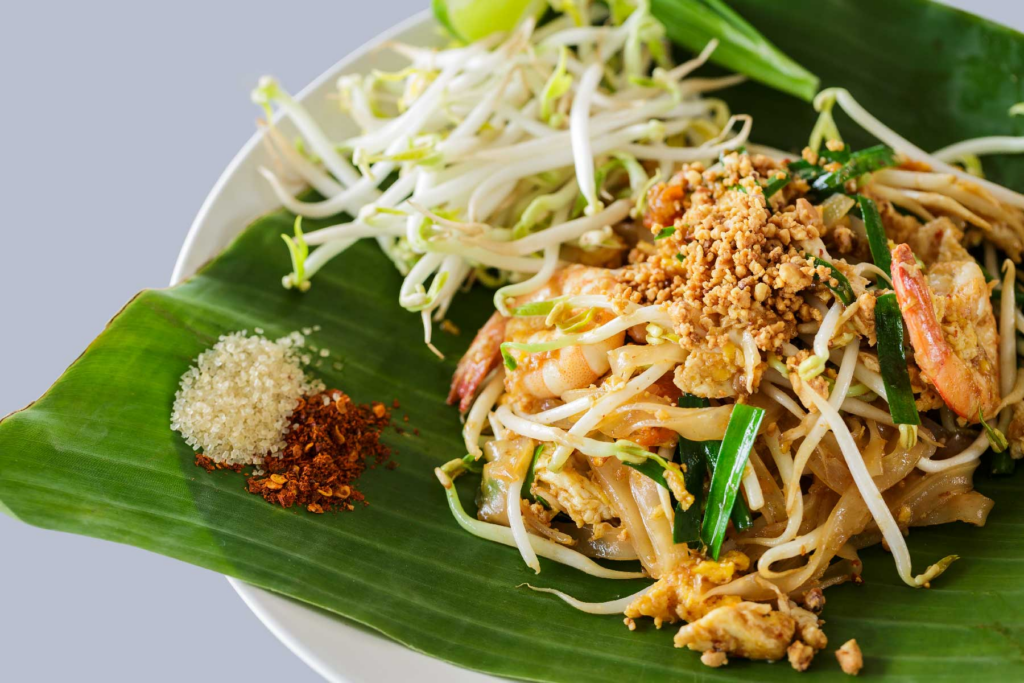
Immune-boosting properties of Ingredients like Chili Peppers and Lime Juice
Thai cuisine is renowned for its use of ingredients that not only tantalize the taste buds but also offer various health benefits. Chilli peppers, a staple in many Thai dishes, contain high levels of vitamin C and capsaicin, a compound known for its immune-boosting properties. Similarly, lime juice, often used in Thai salads and soups, is rich in vitamin C, antioxidants, and flavonoids, which help strengthen the immune system and protect against infections.
Weight Management through Balanced Dishes and Portion Control
Thai cuisine is characterized by its balance of flavours and textures, incorporating a variety of ingredients such as lean proteins, fresh vegetables, and complex carbohydrates. By prioritizing whole, nutrient-dense foods and minimizing the use of processed ingredients, Thai dishes offer a satisfying and filling dining experience without excessive calories or unhealthy fats. Furthermore, traditional Thai eating customs, which often involve communal dining and shared dishes, promote mindful eating and portion control, contributing to weight management and overall health.
Digestive Health Benefits from Herbs, Spices, and Fermented Foods
Herbs and spices play a vital role in Thai cuisine, not only enhancing the flavour of dishes but also aiding digestion and promoting gastrointestinal health. Ingredients such as lemongrass, ginger, and galangal possess anti-inflammatory and antimicrobial properties, which can help soothe digestive discomfort and alleviate symptoms of indigestion. Additionally, fermented foods like fish sauce and shrimp paste, commonly used in Thai cooking, contain probiotics that support a healthy gut microbiome and improve digestive function.
Nutritional Advantages of Staple Dishes like Steamed Fish and Brown Rice
Staple dishes in Thai cuisine, such as steamed fish and brown rice, offer a plethora of nutritional benefits. Steamed fish is an excellent source of lean protein, omega-3 fatty acids, and essential vitamins and minerals, promoting heart health, brain function, and muscle repair. Brown rice, a whole grain rich in fibre and antioxidants, provides sustained energy, regulates blood sugar levels, and supports digestive health. By incorporating these nutrient-rich staples into their diet, individuals can enjoy delicious Thai meals while reaping the nutritional rewards.
Role of Thai Soups and Salads in Promoting Hydration and Nutrient Intake
Thai soups and salads are not only refreshing and flavourful but also serve as hydrating and nutrient-dense options. Soups like Tom Yum and Tom Kha are made with clear broths infused with aromatic herbs, vegetables, and protein, providing essential hydration and electrolytes. Similarly, Thai salads, such as Som Tum (green papaya salad) and Yum Woon Sen (glass noodle salad), are packed with fresh vegetables, herbs, and protein, offering a crunchy and satisfying way to increase nutrient intake and support overall health.
Exploring Specific Thai Dishes and Their Health Benefits
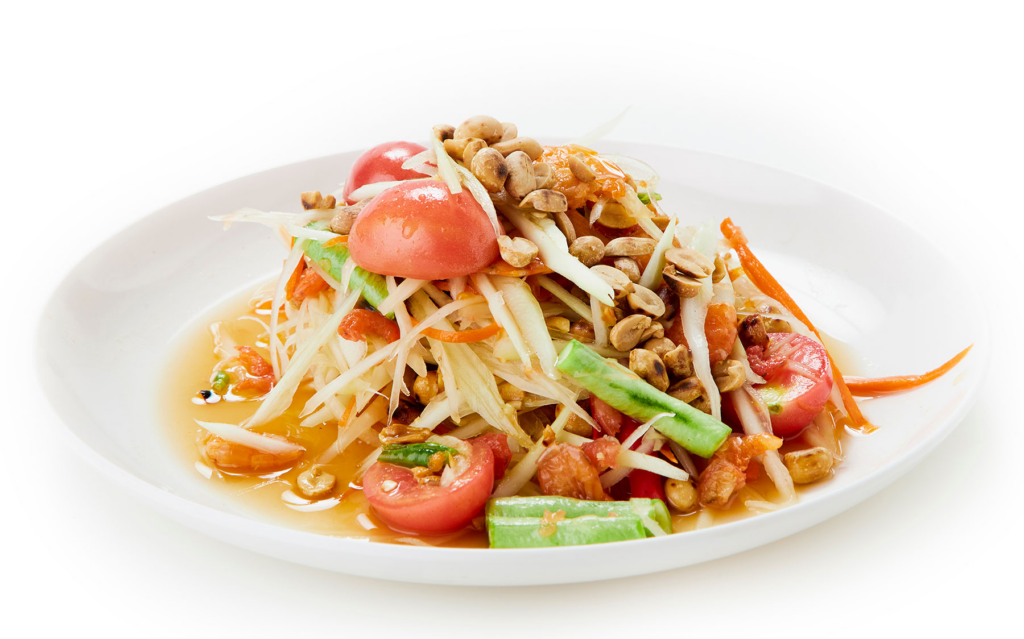
Thai cuisine boasts a rich variety of dishes that are beloved worldwide for their bold flavours and aromatic spices. Among the most iconic are Pad Thai, Tom Yum Soup, and Green Curry, each offering a unique culinary experience that tantalizes the taste buds and nourishes the body.
Highlighting the Nutritional Profiles and Health Benefits of Each Dish
1. Pad Thai: This classic stir-fried noodle dish is a staple of Thai cuisine, featuring a harmonious blend of rice noodles, vegetables, protein (often shrimp or tofu), and a flavourful sauce made from tamarind, fish sauce, and palm sugar. Despite its indulgent taste, Pad Thai can be a nutritious choice, especially when prepared with plenty of fresh vegetables and lean protein. The dish provides essential nutrients such as protein, fibre, vitamins, and minerals, contributing to overall health and well-being.
2. Tom Yum Soup: Known for its spicy, sour, and aromatic broth, Tom Yum Soup is a popular Thai soup that is both refreshing and invigorating. Made with ingredients like lemongrass, kaffir lime leaves, galangal, chilli peppers, and lime juice, this soup is packed with antioxidants, vitamins, and immune-boosting properties. The combination of spicy and sour flavours not only stimulates the appetite but also aids digestion and promotes a sense of vitality and well-being.
3. Green Curry: A fragrant and vibrant dish, Green Curry is a Thai curry made with a paste of green chili peppers, garlic, lemongrass, galangal, and other herbs and spices, simmered in coconut milk with vegetables and protein. Despite its creamy texture, Green Curry can be a healthy choice when prepared with lean proteins like chicken or tofu and an abundance of fresh vegetables. The dish offers a wealth of nutrients, including vitamins, minerals, and healthy fats from coconut milk, supporting overall health and vitality.
Recommendations for Healthier Cooking Methods and Ingredient Substitutions
While traditional Thai dishes are delicious and satisfying, they can sometimes be high in sodium, sugar, and unhealthy fats. To enjoy these dishes without compromising health, consider the following tips:
- Opt for lean proteins such as tofu, chicken breast, or seafood instead of fatty cuts of meat or fried proteins.
- Use coconut milk sparingly and choose light or reduced-fat versions to lower the calorie and fat content of dishes.
- Incorporate plenty of fresh vegetables into your Thai recipes to boost fibre and nutrient intake while adding texture and flavour.
- Be mindful of portion sizes and avoid overindulging in high-calorie or high-fat dishes.
- Experiment with homemade versions of Thai sauces and pastes to control the quality and quantity of ingredients, reducing the amount of added sugar, salt, and preservatives.
- Substitute refined carbohydrates like white rice or noodles with whole grains or alternatives like brown rice, quinoa, or cauliflower rice for added fibre and nutritional benefits.
Addressing Common Misconceptions and Concerns
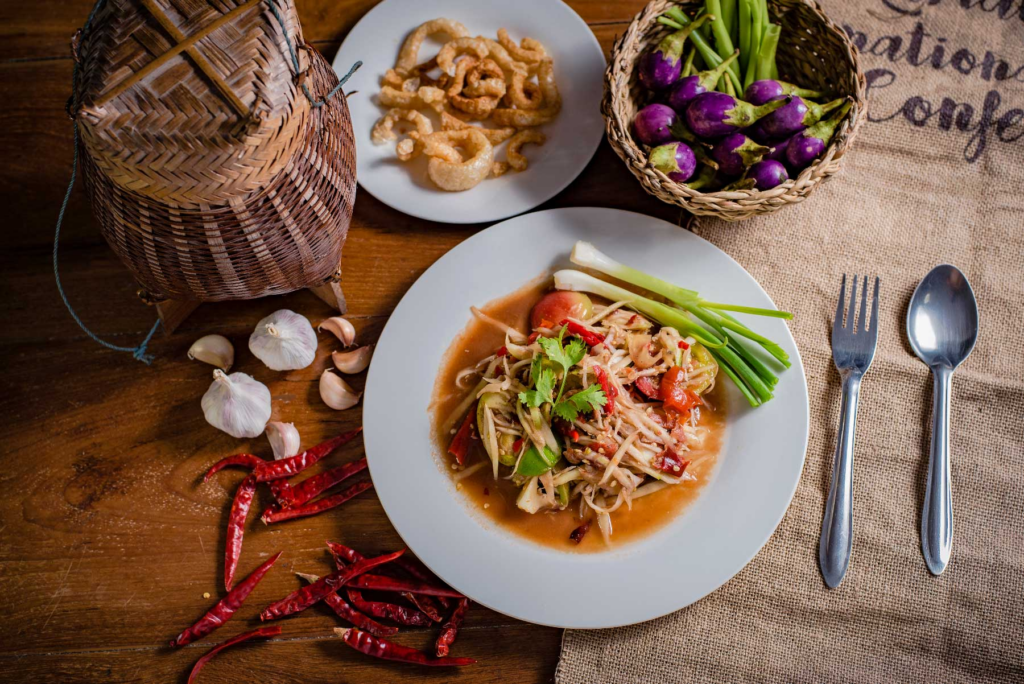
Thai cuisine is often misunderstood as being inherently high in fat and calories due to its rich and flavourful dishes. However, this misconception overlooks the diversity and balance inherent in traditional Thai cooking. While some dishes may indeed be indulgent, many Thai recipes prioritize fresh ingredients, lean proteins, and healthy cooking techniques. So enjoy Thai cuisine as part of a balanced diet.
Strategies for Navigating Restaurant Menus and Making Healthier Choices
When dining out at Thai restaurants, it can be challenging to identify the healthiest options on the menu. To make informed choices:
- Look for Grilled or Steamed Dishes: Opt for dishes that are grilled, steamed, or stir-fried with minimal oil, as these cooking methods tend to be lower in calories and saturated fat compared to deep-frying.
- Choose Lean Proteins: Select dishes with lean protein sources such as chicken, tofu, or seafood, and avoid dishes that are heavily fried or contain fatty cuts of meat.
- Load Up on Vegetables: Incorporate plenty of vegetables into your meal to boost fiber and nutrient intake while keeping calories in check. Thai cuisine offers an array of delicious vegetable-based dishes that are both nutritious and satisfying.
- Watch Portion Sizes: Thai restaurant portions can be generous, so consider sharing dishes or opting for smaller portions to avoid overeating.
- Request Modifications: Don’t hesitate to ask your server for modifications to suit your dietary preferences or restrictions, such as requesting less oil or sauce, or substituting ingredients.
Concerns about Allergens, Food Additives, and Sodium Content in Thai Dishes
While Thai cuisine is generally fresh and flavourful, it’s essential to be mindful of potential allergens, food additives, and sodium content in certain dishes. Here are some tips:
- Communicate Allergies and Dietary Restrictions: Inform restaurant staff of any food allergies or dietary restrictions you may have, such as gluten intolerance or nut allergies, to ensure that your meal is prepared safely.
- Choose Freshly Prepared Dishes: Opt for dishes that are freshly prepared to order rather than pre-packaged or processed options, as they are less likely to contain hidden additives or preservatives.
- Be Mindful of Sodium: Thai cuisine can be high in sodium due to the use of ingredients like fish sauce and soy sauce. To reduce sodium intake, ask for sauces and dressings to be served on the side and use them sparingly.
- Explore Healthier Alternatives: Look for healthier alternatives to traditional dishes, such as brown rice instead of white rice or steamed vegetables instead of deep-fried options, to reduce overall calorie and sodium intake.
By being aware of common misconceptions and concerns surrounding Thai cuisine and implementing these strategies, you can enjoy the vibrant flavours of Thai food while supporting your health and well-being.
Incorporating Thai Cuisine into a Balanced Diet
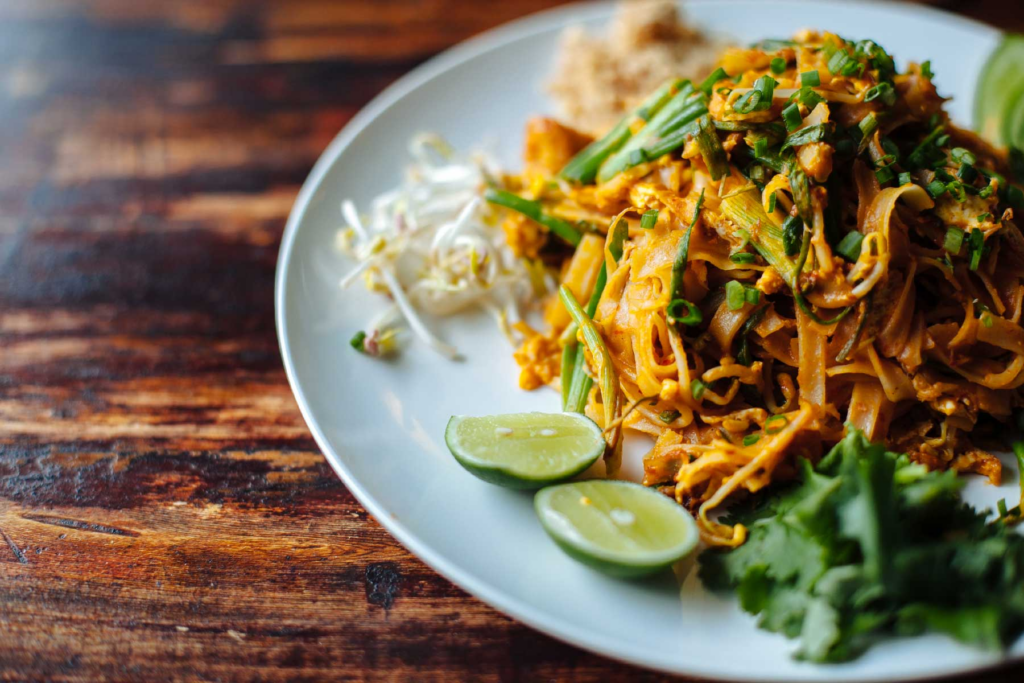
Incorporating Thai cuisine into a balanced diet can add variety and flavour to your meals while providing essential nutrients. Here are some tips:
- Balance Your Plate: Aim for a balanced meal by including a mix of lean protein, complex carbohydrates, and healthy fats. For example, pair a protein-rich Thai curry with brown rice and steamed vegetables.
- Portion Control: Be mindful of portion sizes, especially with calorie-dense dishes like curries and stir-fries. Opt for smaller servings or share dishes to avoid overeating.
- Load Up on Vegetables: Thai cuisine offers a wide range of vegetable-based dishes, such as stir-fries and salads. Load up on colourful vegetables to boost your fibre and nutrient intake while keeping calories in check.
- Choose Lean Proteins: Incorporate lean protein sources like chicken, tofu, or seafood into your Thai meals to support muscle health and keep you feeling satisfied.
- Watch the Sauce: Be cautious of high-calorie sauces and dressings commonly used in Thai cuisine, such as coconut milk-based curries and peanut sauces. Enjoy these sauces in moderation or opt for lighter alternatives.
Strategies for Cooking Thai-Inspired Meals at Home Using Fresh and Healthy Ingredients
Cooking Thai-inspired meals at home allows you to control the ingredients and cooking methods, making it easier to create nutritious dishes. Here’s how:
- Stock Up on Staples: Keep essential Thai ingredients like fish sauce, curry paste, coconut milk, and aromatic herbs like lemongrass, basil, and coriander stocked in your pantry.
- Choose Fresh Ingredients: Opt for fresh, locally sourced ingredients whenever possible. Use plenty of vegetables, herbs, and spices to add flavour and nutrients to your dishes.
- Experiment with Flavours: Don’t be afraid to experiment with different flavour combinations and spices to create your own unique Thai-inspired recipes. Mix and match ingredients to suit your taste preferences and dietary needs.
- Healthy Cooking Methods: Use healthier cooking methods like grilling, steaming, or stir-frying with minimal oil to reduce added fats and calories. Avoid deep-frying and excessive use of oil in your cooking.
- Customize to Taste: Adjust the level of spiciness and seasoning to suit your taste preferences. You can easily control the amount of salt, sugar, and spices used in homemade Thai dishes to make them healthier.
Suggestions for Adapting Traditional Thai Dishes to Accommodate Dietary Restrictions
If you have dietary restrictions or preferences, it’s possible to adapt traditional Thai dishes to suit your needs. Here are some suggestions:
- Gluten-Free Options: Many Thai dishes are naturally gluten-free, but be cautious of soy sauce and certain sauces that may contain gluten. Look for gluten-free alternatives or use tamari sauce instead.
- Vegetarian and Vegan Variations: Thai cuisine offers plenty of vegetarian and vegan options, such as tofu stir-fries, vegetable curries, and noodle dishes. Substitute meat with tofu, tempeh, or a variety of vegetables for a plant-based meal.
- Low-Carb Alternatives: If you’re watching your carb intake, opt for dishes that are served with cauliflower rice or zucchini noodles instead of traditional rice or noodles. You can also request lighter sauces and fewer starchy ingredients in your dishes.
- Allergen-Free Options: Communicate any food allergies or intolerances to restaurant staff when dining out, and ask for ingredient substitutions or modifications to accommodate your dietary needs. When cooking at home, carefully read labels and choose allergen-free ingredients.
By following these tips and strategies, you can easily incorporate Thai cuisine into your balanced diet, enjoy delicious and nutritious meals, and accommodate any dietary restrictions or preferences you may have.
KB Thai – Your Ultimate Destination for Authentic Thai Cuisine in Woy Woy
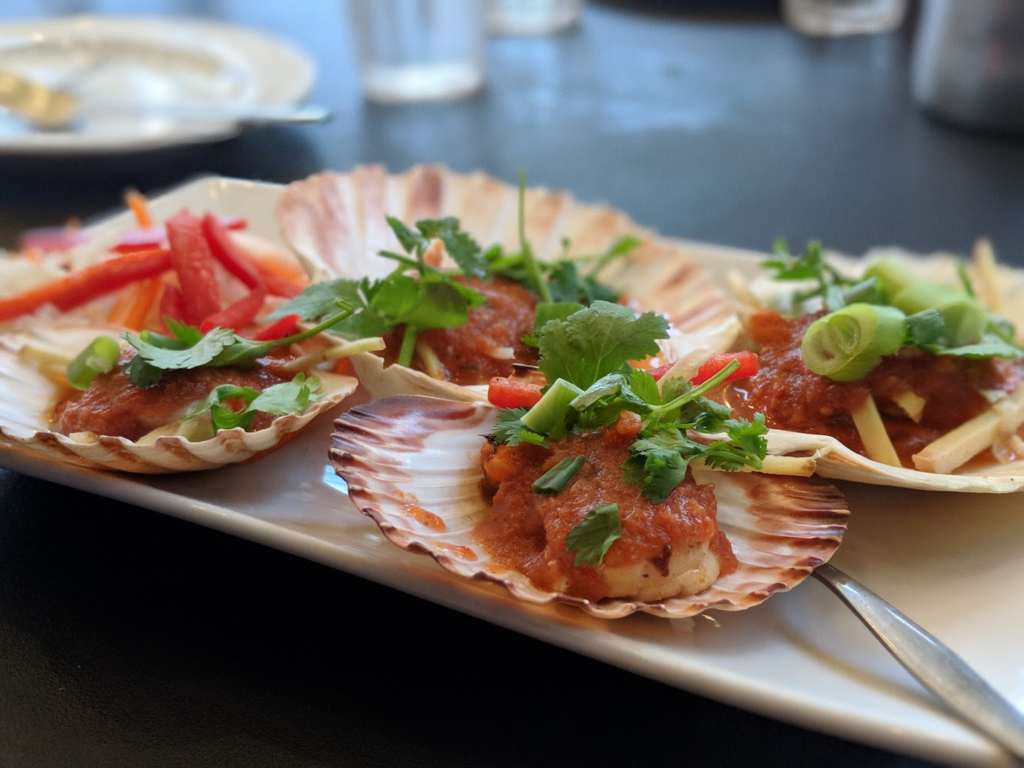
Welcome to KB Thai, where culinary excellence meets traditional Thai flavours right here in Woy Woy! If you’re craving an unforgettable dining experience filled with bold spices, vibrant colours, and mouthwatering aromas, look no further than KB Thai.
Experience Authentic Thai Cuisine
At KB Thai, we pride ourselves on offering an extensive menu featuring a wide array of authentic Thai dishes crafted with care and expertise. From classic favourites like Pad Thai and Green Curry to unique delicacies bursting with exotic flavours, there’s something to tantalise every palate.
Immerse Yourself in Thai Culture
Step into our warm and inviting restaurant, where the rich aromas of Thai herbs and spices instantly transport you to the bustling streets of Thailand. Whether you’re dining with family, friends, or that special someone, our cosy ambience and attentive staff ensure a memorable dining experience every time.
Order Online or Make a Reservation
Ready to embark on a culinary journey to Thailand without leaving Woy Woy? You can now order online for convenient takeaway or delivery straight to your doorstep. Simply browse our menu, select your favourite dishes, and let us take care of the rest.
Alternatively, if you prefer to savour the full dining experience at our restaurant, we recommend making a reservation to secure your table. Whether it’s a casual lunch, intimate dinner, or special celebration, KB Thai is the perfect setting for any occasion.
Conclusion
As we conclude our exploration of the health benefits and culinary delights of Thai cuisine, it’s essential to reflect on the key points that make this cuisine so special.
Throughout this article, we’ve delved into the nutritional components of Thai dishes, highlighting the emphasis on fresh ingredients, lean proteins, and aromatic spices. We’ve uncovered the immune-boosting properties of chilli peppers, the digestive benefits of herbs and spices, and the nutritional advantages of staple dishes like steamed fish and brown rice.
Moreover, we’ve touched upon the mental and emotional well-being fostered by communal dining and the aromatic effects of Thai herbs and spices on mood and stress levels. Thai cuisine isn’t just about nourishing the body; it’s also about feeding the soul and connecting with others through shared experiences.
As we encourage you to explore and enjoy Thai cuisine, we do so with a reminder to indulge in moderation. While Thai dishes offer a plethora of health benefits, balance is key to a well-rounded diet. Whether you’re dining at KB Thai or experimenting with Thai-inspired recipes at home, savour each bite mindfully and appreciate the cultural richness and culinary diversity that Thai food has to offer.
In closing, we celebrate the vibrant tapestry of flavours, textures, and aromas that define Thai cuisine. From the bustling streets of Bangkok to the serene shores of Woy Woy, let the magic of Thai food transport you to a world of culinary delight. So why wait? Embark on your own Thai culinary adventure today and experience the joy of Thai cuisine firsthand.
FAQs (Frequently Asked Questions)
1. What is Thai cuisine?
Thai cuisine refers to the culinary traditions and dishes originating from Thailand, known for its vibrant flavours, aromatic herbs and spices, and diverse range of ingredients such as coconut milk, chilli peppers, and fresh herbs.
2. What are some popular Thai dishes?
Popular Thai dishes include Pad Thai, Tom Yum Soup, Green Curry, Massaman Curry, and Papaya Salad, each offering a unique combination of flavours and textures that represent the rich tapestry of Thai cuisine.
3. Are Thai dishes healthy?
Yes, many Thai dishes are considered healthy due to their emphasis on fresh ingredients, lean proteins, and aromatic herbs and spices. Dishes like steamed fish with brown rice and stir-fried vegetables provide nutritional benefits and are often part of a balanced diet.
4. Is coconut milk used in Thai cuisine?
Yes, coconut milk is a common ingredient in Thai cuisine, adding richness and creaminess to curries, soups, and desserts. While it is high in saturated fat, when consumed in moderation, coconut milk can be part of a healthy diet.
5. What are the health benefits of Thai cuisine?
Thai cuisine offers numerous health benefits, including immune-boosting properties from ingredients like chilli peppers and lime juice, digestive health benefits from herbs and spices, and weight management through balanced dishes and portion control.
6. Can Thai cuisine cater to dietary restrictions?
Yes, Thai cuisine is versatile and can accommodate various dietary restrictions. Many dishes can be made vegetarian or vegan by omitting meat or fish sauce, and gluten-free options are also available, especially with rice noodles replacing wheat noodles in many dishes.
7. Where can I find authentic Thai cuisine in Woy Woy?
KB Thai, located in Woy Woy, offers authentic Thai cuisine prepared with traditional recipes and fresh ingredients. You can experience the authentic flavours of Thailand by dining at KB Thai or ordering online for takeaway or delivery.
8. Are there healthier options available at Thai restaurants?
Yes, most Thai restaurants offer a variety of healthier options, such as steamed dishes, grilled meats, and stir-fried vegetables. Additionally, you can request dishes to be prepared with less oil or sodium to suit your dietary preferences.
9. Do Thai dishes contain a lot of spices?
Thai dishes are known for their bold and aromatic flavours, which often come from a combination of herbs and spices such as lemongrass, galangal, and coriander. While some dishes may be spicy, the level of heat can often be adjusted to suit individual preferences.
10. What sets Thai cuisine apart from other Asian cuisines?
Thai cuisine is distinguished by its unique balance of sweet, sour, salty, and spicy flavours, as well as its emphasis on fresh ingredients and aromatic herbs and spices. Additionally, Thai dishes often showcase a harmonious blend of textures, making each bite a delightful experience.

